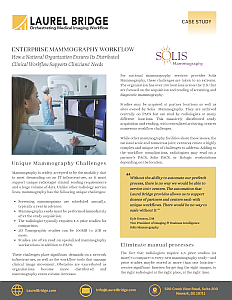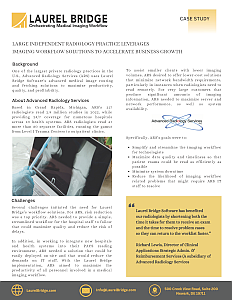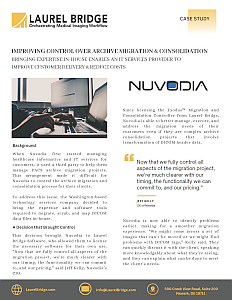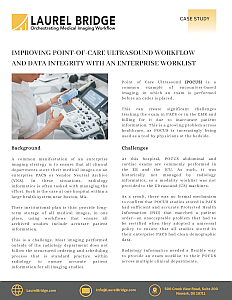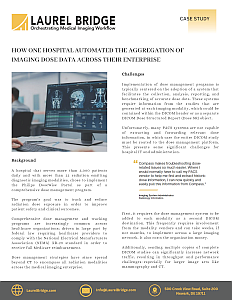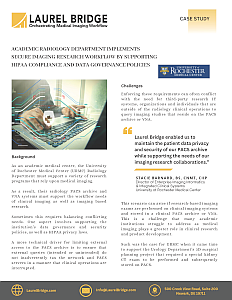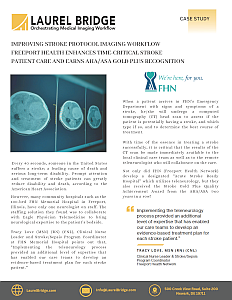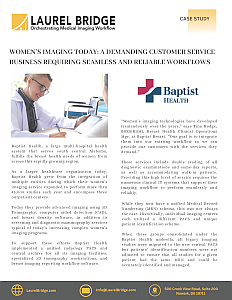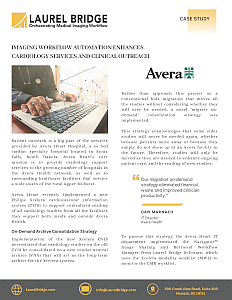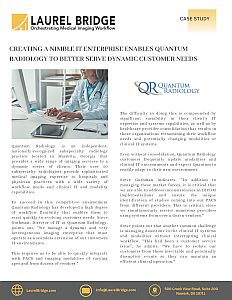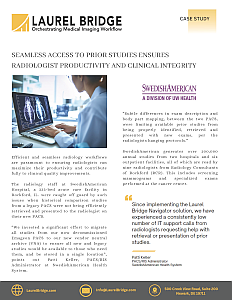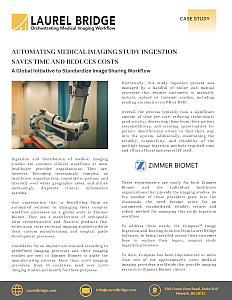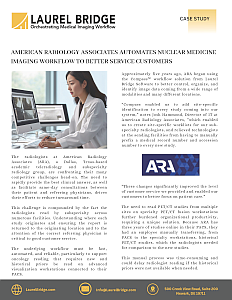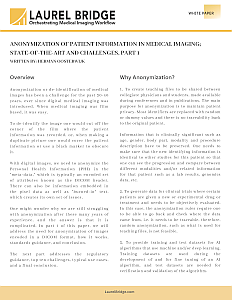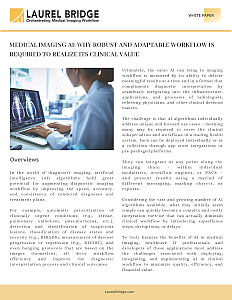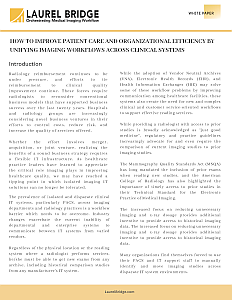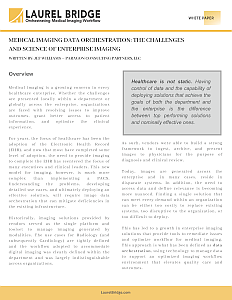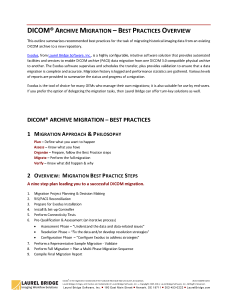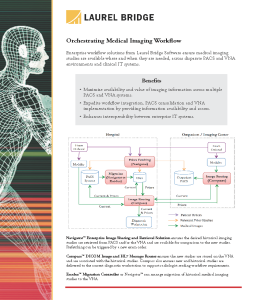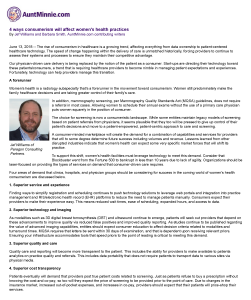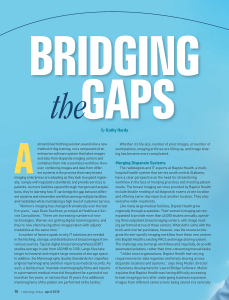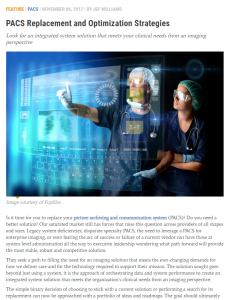Enterprise Mammography Workflow: How One National Organization Ensures Its Distributed Clinical Workflow Supports Clinicians Needs
Mammography is widely accepted to be very demanding on an IT infrastructure, as it must support unique radiologist clinical reading requirements and huge volumes of data. These challenges place significant demands on the workflow tools that manage clinical image movement, which only increase as organizations become more distributed and mammography exam volume increases.
Read this case study to learn how Solis Mammography, a national mammography services provider, is leveraging workflow automation to ensure current and prior studies are getting to the right radiologist, in the right place and at the right time to:
- Maximize radiologist productivity and ensure the delivery of a high-quality mammography service.
- Enable their radiologists to read all studies on the PACS they are familiar, with appropriate hanging protocols, regardless of where the studies originated.
- Ensure all new studies are read with the appropriate priors being available, regardless of where they were acquired.
Large Independent Radiology Practice Leverages Imaging Workflow Solutions to Accelerate Business Growth
Growing any radiology business requires the implementation of strategic technology solutions that enable the business to scale efficiently. Managing risk, ensuring the organization operates efficiently, and enabling the organization to meet the needs of various sized clients are all critical strategic challenges.
Read this case study to learn how Advanced Radiology Services (ARS) has been leveraging the capability of Laurel Bridge Software over the past 11 years as a catalyst for enabling their enterprise imaging strategy. Learn how ARS has:
- Simplified and streamlined their technologists imaging workflow
- Maximized data quality and timeliness so that patients exams can be read as efficiently as possible
- Minimized system downtime
- Reduced the likelihood of imaging workflow related problems that place unnecessary demands on ARS IT staff
MarinHealth Improves Radiologist Productivity and Report Quality by Automatically Integrating Structured Measurement Data
Structured measurement data is a critical part of numerous medical imaging exams. It typically includes critical information that adds clinical value to the radiologist report. Ensuring this information is properly and accurately incorporated into the report requires an automated process that eliminates manual intervention.
Read this case study to learn how MarinHealth automated their structured reporting and dictation integration workflow to:
- Improve radiologist and clerical staff productivity
- Enhance the quality, consistency, and accuracy of every radiologist report.
Improving Control over Archive Migration and Consolidation – Nuvodia
Bringing expertise in-house enables an IT services provider to improve customer delivery and reduce costs
When Nuvodia first started managing healthcare informatics and IT services for customers, it used a third party to help them manage PACS archive migration projects. This arrangement made it difficult for Nuvodia to control the archive migration and consolidation process for their clients. To address this issue, the Washington-based technology services company decided to bring the expertise and software tools required to migrate, scrub, and map DICOM data files in-house.
Read this case study to learn how Nuvodia accomplished more efficient, responsive, and effective control of archive migration and consolidation for their customers using the Exodus™ Migration and Consolidation Controller from Laurel Bridge Software.
Improving Point-Of-Care Ultrasound Workflow and Data Integrity with an Enterprise Worklist
A common manifestation of an enterprise imaging strategy is to ensure that all clinical departments store their medical images on an enterprise PACS or Vendor Neutral Archive (VNA). In these situations, radiology informatics is often tasked with provide long-term storage of all medical images, in one place, using workflows that ensure all archived studies include accurate patient information.
But this can be a big challenge as most imaging performed outside of the radiology department does not follow the structured ordering and scheduling process that is standard practice in radiology to ensure accurate patient information for all imaging studies.
Read this case study to learn how one hospital utilized the Waypoint Encounter & Modality Worklist Manager from Laurel Bridge Software to:
- Ensure clean data in their enterprise PACS for Point of Care ultrasound (POCUS) acquired outside of radiology.
- Enable all imaging studies to be properly identified in PACS and accessible when they must be retrieved.
- Provide openness and flexibility that is beneficial to their enterprise imaging strategy.
How One Hospital Automated the Aggregation of Imaging Dose Data Across Their Enterprise
Implementing a dose management program typically centers on the adoption of a system that facilitates the collection, analysis, reporting, and benchmarking of accurate dose data. These systems require study information that is contained within the DICOM header of each image or may exist as a separate DICOM Dose Structured Report (Dose SR) object.
Unfortunately, many PACS systems are not capable of extracting and forwarding relevant dose information, resulting in the entire DICOM study being routed to the dose management platform. This presents some significant challenges for hospital IT and administration.
Read this case study to learn how a medium-size hospital leveraged the Compass™ Routing Workflow Manager from Laurel Bridge Software to:
- Automatically identify and extract the Dose SR object and forward it to their dose management
system for analysis and tracking. - Facilitate troubleshooting of dose-related issues.
- Simplified the management and connectivity between the organizations many radiation emitting
modalities and their dose analysis system.
Academic Radiology Department Implements Secure Imaging Research Workflow – URMC
Supports HIPAA Compliance and Data Governance Policies
Many academic and research-oriented radiology departments have a responsibility to support image-based research. As a result, their radiology PACS archive and VNA must support both clinical and research imaging workflow needs. This requires the clinical IT infrastructure to support enterprise imaging data governance and security policies, HIPAA privacy laws and ensure clinical operations are not interrupted.
Read this case study to learn how the University of Rochester Medical Center utilized the Compass™ Routing Workflow Manager from Laurel Bridge Software to:
- Maintain patient data privacy and security while supporting the needs of imaging research.
- Manage and control access to their PACS.
Improving Stroke Protocol Imaging Workflow – Freeport Health
Hospital Improves Stroke Patient Care by Automating Time Critical, Teleneurology Imaging Workflows
Every 40 seconds someone in the United States suffers a stroke, a leading cause of death and serious long-term disability. Prompt attention and treatment of stroke patients can greatly reduce disability and death, according to the American Heart Association. The 100-bed FHN Memorial Hospital in Freeport, Illinois, with only one neurologist on staff decided to partner with Eagle Physician Telemedicine to bring neurological expertise to their stroke patient’s bedside. As a result, they became a designated Acute Stroke Ready Hospital and received the AHA/ASA Stroke Gold Plus Quality Achievement Award two years in a row.
Read this case study to learn how FHN Memorial Hospital achieved this accomplishment by reliably automating the distribution of time-critical CT head scans to the onsite radiologist and the remote teleneurologist, while improving staff productivity, using a Laurel Bridge workflow solution.
Women’s Imaging Today – Baptist Health
A Customer Service Business Requiring Seamless and Reliable Workflows
The Women’s Imaging service at Baptist Health has grown through mergers and acquisition, much like countless healthcare services in the U.S.. This is merely one factor, along with the need to integrate new breast imaging modalities and the evolution of Women’s Imaging into a demanding customer service business that must be addressed by their clinical IT systems. As a result, their disparate clinical IT environment resulted in complex, site specific imaging workflows that needed to be reliably automated.
Read this case study to learn how Baptist Health, a large multi-hospital health system, fulfills the complex and time sensitive breast health needs of women across south central Alabama, with the help of Laurel Bridge workflow solutions.
Cardiology Multisite Workflow – Avera Heart Hospital
Imaging Workflow Automation Enhances Cardiology Services and Clinical Outreach
Cardiology archive consolidation onto a VNA and CVIS replacement impose significant resource and study identification challenges that even the largest hospitals must address efficiently. In addition, multisite reading workflow incorporating historical prior studies is the new standard of care that can be a challenge to implement as growing healthcare networks rely upon heterogeneous IT systems.
Read this case study to learn how the Avera Heart Hospital, a rural cardiac specialty hospital that provides centralized support services to all hospitals in the Avera Health Network, has addressed these challenges with Laurel Bridge workflow solutions and has eliminated financial waste, improved clinician productivity and enhanced healthcare quality.
Virtual Enterprise – Quantum Radiology
Creating a Nimble IT Enterprise Enables Quantum Radiology to Better Serve Dynamic Customer Needs
A successful radiology imaging services provider must be able to react quickly to evolving customer needs and interface with PACS and imaging modalities of varying ages and from dozens of vendors. This requires a high degree of workflow flexibility, including the ability to manage inconsistencies in DICOM implementations and ensure unique identification of incoming studies.
Read this case study to learn how Quantum Radiology, a nationally-recognized subspecialty radiology practice, provides reliable and efficient clinical operations for their clients by developing a “virtual enterprise” that is enabled by their implementation of a Laurel Bridge workflow solution.
Radiology Workflow – SwedishAmerican
Seamless Access to Prior Studies Ensures Radiologist Productivity and Clinical Integrity
When radiologists have timely access to relevant historical clinical information they are able to maintain their productivity and enhance their clinical confidence, which in turn, creates opportunities to play a greater consultative role that benefits overall clinical quality.
Read this case study to learn how the radiologists who read for the SwedishAmerican Hospital benefited from improved information access to realize the full potential of their new Vendor Neutral Archive (VNA).
Automating Workflow – Zimmer Biomet
Automating Medical Imaging Study Ingestion Saves Time and Reduces Costs
Ingestion and distribution of medical images is a common workflow at most healthcare organizations but is one that can become very complicated as the complexity of an organization increases. Manual or unreliable mechanisms for handling these complexities can add costs, hamper productivity and limit initiatives to improve patient care.
Read this case study to learn how Zimmer Biomet, a global organization, has lowered implementation and support costs, addressed strict security requirements, and improved technologist productivity by standardizing on a Laurel Bridge workflow solution.
Teleradiology – American Radiology Associates
American Radiology Associates Automates Nuclear Medicine Imaging Workflow to Better Service Customers
The increasingly competitive healthcare environment requires teleradiology service providers to provide unique services at minimal cost. The medical imaging workflows required to meet these goals can be convoluted and complex, yet must function in an automated, timely and reliable manner to ensure high quality care is delivered.
Read how American Radiology Associates solved their complex PET/CT workflow and improved customer satisfaction which enabled development of new business opportunities.
Anonymization of Patient Information in Medical Imaging
State-of-the-Art and Challenges, Part 2
The challenges of anonymizing medical images has existed ever since digital medical imaging was introduced. In fact, it has become more complex with the advent of cloud based workflows and image based AI research.
Digital images require anonymization of the Personal Health Information in the DICOM header, the pixel data, and the “burned-in” text. One might wonder why we are still struggling with anonymization after so many years of experience. The answer is that it is complicated!
This white paper is valuable for imaging IT professionals looking to:
- Understand what anonymization is and why it is important.
- Learn how anonymization works and what is included.
- Appreciate why re-identification is important.
After reading this second part of the two-part white paper you will understand:
- Top ten anonymization challenges.
- Typical anonymization use cases and workflows.
- Available regulatory guidance around anonymization.
Anonymization of Patient Information in Medical Imaging
State-of-the-Art and Challenges, Part 1
Anonymization of medical images has been a challenge ever since digital medical imaging was introduced. When it was film based, de-identifying an image was easy; one would simply cut off the corner of the film that included the patient information, or, when making a duplicate one would cover the patient information or obscure it with a black marker.
However, digital images require anonymization of the Personal Health Information in the DICOM header, the pixel data and in “burned-in” text. One might wonder why we are still struggling with anonymization after so many years of experience. The answer is that it is complicated.
This white paper is valuable for imaging IT professionals looking to:
- Understand what anonymization is and why it is important.
- Learn how anonymization works and what is included.
- Appreciate why re-identification is important.
After reading this first part of the two-part white paper you will understand:
- Challenges of fully automating the anonymization process.
- Importance of flexibility when planning the process.
- Guidance provided by medical imaging standards.
Medical Imaging AI
Why Robust and Adaptable Workflow is Required to Realize its Clinical Value
In the world of diagnostic imaging, artificial intelligence (AI) algorithms hold great potential for augmenting diagnostic imaging workflow by improving the speed, accuracy, and consistency of rendered diagnoses and treatment plans. To truly harness the benefits of AI in medical imaging, healthcare IT professionals and developers of these applications must address the challenges associated with deploying, integrating, and implementing AI in clinical workflow to maximize quality, efficiency, and financial value.
This white paper is valuable for imaging IT professionals looking to:
- Develop and implement medical imaging AI applications and algorithms.
- Understand medical imaging workflow challenges that are unique to AI applications and algorithms.
- Learn about the tools required to ensure the value of medical imaging AI is realized.
After reading this white paper you will understand:
- The unique workflow challenges surrounding the different algorithm deployment scenarios.
- The workflow factors that will affect successful AI algorithm implementation and adoption.
- How the Laurel Bridge Software AI Workflow Suite can facilitate the implementation of medical imaging AI algorithms.
Imaging Workflow
How to Improve Patient Care and Organizational Efficiency by Unifying Imaging Workflows Across Clinical Systems
In the increasingly competitive healthcare environment, imaging services provide critical support to the clinical and operational needs of an organization. The workflows that enable these services must be automated, timely and reliable to ensure that valuable clinical and IT resources can focus on patient care.
This white paper is valuable for medical imaging professionals looking to:
- Gain awareness of the hidden costs of inefficient enterprise imaging workflows.
- Resolve inefficient enterprise imaging workflows.
- Develop new clinical services.
After reading this white paper you will understand the many benefits of automating enterprise imaging workflows, including:
- Increased clinical quality and patient care.
- Improved customer service and competitiveness.
- Increased organizational efficiency and productivity.
Medical Image Data Orchestration
The Challenges and Science of Enterprise Imaging
Images are generated across the enterprise and in many cases reside in disparate systems. In addition, the need to access data and define relevance is more nuanced. Finding a single solution that meets every demand within an organization can be costly, disruptive, or difficult to deploy, which has led to the development of Enterprise Imaging tools that can be used to remediate issues and optimize medical imaging workflow. This approach is known as Data Orchestration.
This white paper is valuable for imaging IT professionals looking to:
- Integrate imaging workflows across disparate systems and departments.
- Gain insight into common imaging workflow use cases.
- Understand the technical workflow issues that are often encountered.
After reading this white paper you will understand:
- How departmental vs. enterprise imaging workflow orchestration issues can differ.
- The thought process one should follow when solving imaging workflow problems.
- The role that specialized imaging workflow tools can play.
Customer Success Webinar Series: Innovative Solutions for AI Workflow Initiatives at Solis Mammography (Episode 1)
In this first-ever Laurel Bridge Customer Success Webinar, Kyle Henson, Vice President of Imaging & Business Intelligence at Solis Mammography, joins us to discuss how Laurel Bridge solutions have helped Solis realize their AI vision by automating imaging workflows, de-identification, results delivery, and data verification.
View this webinar to learn more about how:
- Compass and Navigator can be used together to automate imaging AI Workflow
- Discrete data can be extracted from AI results and sent to the EHR
- How Exodus can be used to validate AI datasets
This video is a great companion to the Solis Mammography case study, Enterprise Mammography Workflow: How One National Organization Ensures Its Distributed Clinical Workflow Supports Clinicians Needs.
Medical Imaging Anonymization Challenges and Insights: Perspectives from Herman Osterwijk
View this video to hear noted medical imaging informatics educator and consultant Herman Osterwijk share his thoughts about medical imaging anonymization. He addresses the following common questions:
- What is medical imaging anonymization and what does it involve?
- What are some of the top challenges of medical imaging anonymization?
- Why is re-identification of medical images also important?
- What are the common use cases for anonymization?
- How has the explosion of AI algorithms impacted the importance of anonymization?
- What type of guidance do the medical imaging standards provide?
This video is a nice companion to the two white papers that Herman wrote about medical imaging anonymization. They can be found here and here.
Medical Imaging AI Workflow Anonymization and Re-identification Workflow using the Compass Router
View this video to learn how Compass can be used to:
- Anonymize medical images before they are sent to the cloud for processing by an AI algorithm.
- Re-identify the AI report and processed medical images before being sent to the local PACS.
- Ensure the patient demographic information never leaves the sending institution, is encrypted at the sending institution, and can only be accurately replaced there.
4 Ways Consumers will Affect Women’s Health Practices
Jef Williams and Barbara Smith. AuntMinnie.com, June 13, 2018. Article makes the case for meeting the changing and consumer-driven needs in the women’s healthcare industry with technological agility, using software tools and solutions. Laurel Bridge software solutions, including Compass, Navigator, and Exodus meet this need.
Bridging the Gaps
Kathy Hardy. Radiology Today, April, 2018, vol. 19, no. 5, pp. 10-13. Article reports success story of Baptist Health using Laurel Bridge Solutions to streamline their imaging workflow enterprise.
PACS Replacement and Optimization Strategies
Jef Williams. Imaging Technology News, November-December issue, Nov. 6, 2017, pp. 34-36. Article argues that a deep understanding of imaging software tools and platforms is vital to success in the PACS management industry. Laurel Bridge software solutions, including Exodus, Compass, and Navigator support such enterprise-scale success.

